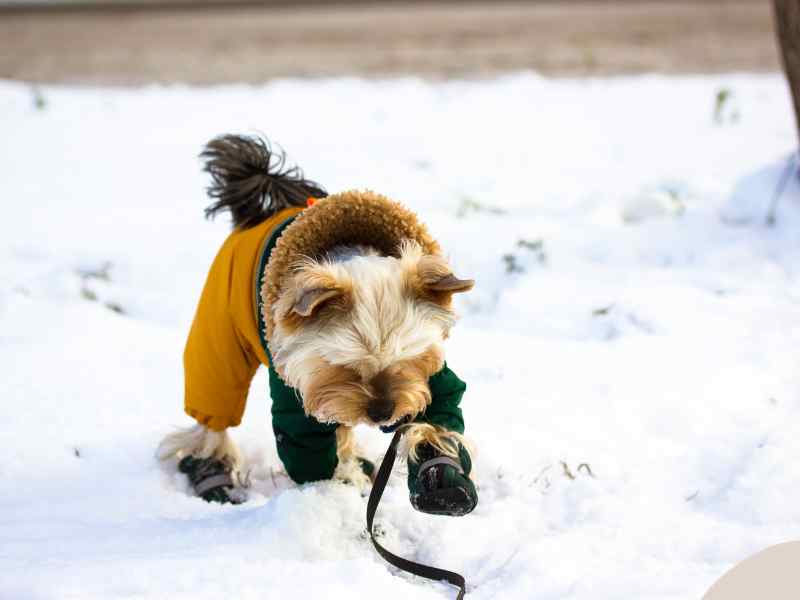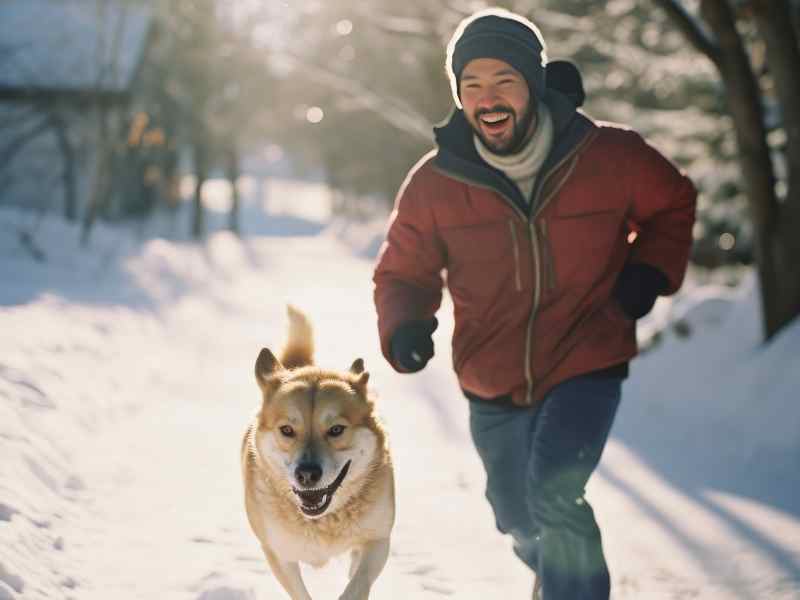As the crisp chill of winter sets in, our furry best friends might need a little extra care, especially those battling joint pain. Just like in humans, cold weather can significantly affect dogs with joint issues, often exacerbating the discomfort and stiffness they experience. This isn’t just an old wives’ tale; there’s a scientific basis behind it. Lower temperatures can lead to the thickening of joint fluid, making joints stiffer and more sensitive.
Dog Joint Pain Relief When Winter Comes Knocking
Though there isn’t really a definitive scientific agreement on what it is about cold weather that makes dog joints hurt, the possibility that cold weather can worsen joint pain in dogs is supported by anecdotal evidence and similarities observed in human and animal studies. That’s why taking measures to keep dogs warm and comfortable during cold weather, and doing what you can to help if you notice increased joint pain or stiffness in your dog during colder months, is important.
For dogs with conditions like arthritis, which is essentially the inflammation of joints, this seasonal change can be more than just an inconvenience. It can profoundly impact their quality of life. That’s why understanding what’s happening and proactively managing your dog’s joint pain during these colder months is crucial.
The thing is, we don’t just want to alleviate pain; it’s about nurturing their overall well-being. As responsible pet parents, we want to make sure that the drop in temperature doesn’t have to mean a drop in their happiness and activity levels.
Why Is Dog Joint Pain Worse In Winter?
The worsening of joint pain in dogs during cold weather is a phenomenon that combines your dog’s physiology with the environmental changes of the season. There are several reasons why our canine companions might feel more discomfort in their joints when the temperature drops:
- Reduced Activity: Colder weather often leads to decreased physical activity. Believe it or not, less movement can actually result in the stiffening of joints. This can aggravate pain and increase discomfort in dogs, especially those already dealing with joint issues. Moving really is better for them, but it hurts, so they don’t want to–it’s a sad cycle we often see in the winter.
- Thickening of Joint Fluid: Lower temperatures can cause the fluid within joints to thicken, leading to increased joint stiffness. This fluid, known as synovial fluid, acts like a lubricant, allowing smooth joint movements. When it thickens, the ease of movement is reduced, and movement hurts your dog more.
- Barometric Pressure Changes: Some studies suggest that changes in barometric pressure, which often occur alongside colder weather, might affect joint pain. A pressure drop could cause joint tissues to expand, leading to increased pain, especially in inflamed or canine arthritis.
- Heightened Pain Perception: There’s also a theory that dogs, like humans, may experience a heightened perception of pain during colder weather due to changes in their pain threshold.
Signs of Joint Pain In Dogs During Winter Months
Identifying signs of joint pain in dogs is important during winter months when your dog’s joints and mobility are more likely to be affected. Here are some things you can watch for:
- Limping or Favoring One Leg: This can be one of the first signs of joint pain. Your dog may limp or favor one leg over the other, especially after getting up from rest.
- Difficulty Moving: Struggling to get up, lie down, or use stairs can indicate discomfort in their joints. If it looks like it’s a pain for them to get up, it likely is.
- Changes in Behavior: Dogs in pain might become more withdrawn, irritable, or less active. They may also show less interest in activities they usually enjoy.
- Licking, Chewing, or Biting: Dogs might lick or bite at the areas that hurt, which could be their way of coping with pain.
- Different Posture: A hunched back or other unusual posture can also be a sign of discomfort.
- Reluctance to Play or Exercise: If your dog seems less eager to play or go for walks, it might be due to joint pain.
Managing Joint Pain In Dogs In Cold Weather
When managing joint pain in dogs, especially in colder weather, it’s important to strike the right balance between maintaining their mobility and not overexerting sore joints. Here are some exercise, therapy, and alternative treatment strategies that can help:
Cold Weather Exercises for Dogs with Joint Pain:
- Short, Frequent Walks: Keeping walks short but frequent can help maintain joint mobility without causing excess strain.
- Low-Impact Activities: Activities such as indoor swimming or underwater treadmill sessions can be excellent for keeping muscles strong while minimizing joint stress.
- Controlled Play: Engage in gentle play that avoids high-impact movements like jumping or sharp turns. Toys that encourage slow and steady movement can be beneficial. If you’re outside in wintry weather, remember that they’re capable of slipping and hurting themselves just like you are. Be careful, and monitor their movements.
Physical Therapy and Massage:
- Physical Therapy: A certified canine rehabilitation therapist can develop a tailored exercise regimen that safely strengthens the muscles around the joints, improving support and reducing pain.
- Massage: Gentle massage can increase circulation to the joints, reduce muscle tension, and help alleviate pain. Techniques like effleurage (light strokes) and petrissage (kneading) are often used.
Winter Weather Routines To Help Joint Pain In Dogs
Creating a daily routine to manage your dog’s joint pain, especially during the chillier months, is all about balancing activity with rest and recovery. If it’s chillier and you notice your dog doesn’t want to move as much, here are some things you can incorporate into your winter routines.
- Gentle Exercise: First off, keep your dog on the move but don’t overdo it. Gentle walks are the go-to; they keep the joints limber without adding strain. Picture a leisurely stroll through the park rather than a sprint. And if your pooch seems to be having a good day, resist the urge to extend that walk. Consistency is key.
- Warm Compresses: Think of this as a little spa treatment for your dog. Warm compresses can soothe sore joints, easing the stiffness. It’s like giving their achy parts a gentle hug with a warm, damp towel. A good rule of thumb is to apply the warmth for up to 15 minutes, but stay tuned to your dog’s comfort level.
- Monitoring: Keep a close eye on how your dog is doing. Some days they might be raring to go, other days not so much. Watching their behavior, like how they get up from their bed or how eagerly they go for a toy, can give you clues about how they’re feeling.
- Adjusting Activities: Knowing your dog’s limits is like being a good dance partner — you’ve got to sense when to lead and when to follow. It’s time to switch things up if they’re limping or lagging. Maybe swap a walk with a gentle game indoors, or encourage them to play with a treat-dispensing toy that’ll get them moving without the high impact.
- Adapt Outdoor Activities: On milder days, encourage short outdoor excursions to get fresh air and a change of scenery, which can lift your dog’s spirits. Protecting them with doggy coats or sweaters can make this more comfortable.
- Adding Supplements: Regularly adding joint supplements for dogs can help during cold weather.
Remember, each dog is an individual, and their response to pain can vary widely. Some might soldier on, hardly showing discomfort, while others may be more vocal or withdrawn. The key is to listen to what your dog is telling you and adapt as needed.
Joint pain in dogs during the colder months can be particularly challenging, not just for their physical comfort but also for their mental well-being. When the temperature drops, dogs with joint issues may become less active due to discomfort, which can decrease the mental stimulation that comes from their regular activities.
That’s why it’s important to remember that your empathy and adaptability can make a big difference in how your dog copes with joint pain during cold weather. Especially during colder winter months, it’s about finding new ways to enjoy life within their limits, keeping their minds engaged, and their hearts happy.
Natural Supplementation For Joint Pain In Dogs
When managing your dog’s joint pain, especially in cold weather, you want to consider the latest research on effective ingredients that can support joint health. While glucosamine, chondroitin, and MSM have been popular in the past, emerging research points to other ingredients that might offer better support for your dog’s mobility.
As we’ve looked to help our own dogs, we looked for the best ingredients for dog joint pain relief. We didn’t want what was popular if there was not enough research to support the efficacy. So, we began working with the best scientists and experts in dog nutrition to come up with ingredients that truly made a difference–ones that could help reduce discomfort, help battle degenerative joint disease, and even be everyday supplements to help ward off chronic pain. When we created Bernie’s Marvelous Mobility and Bernie’s Healthy Hips, we weren’t looking for trendy joint supplement ingredients but ones we could count on for pain control and joint health, especially during winter months. They include:
- Omega-3 Fatty Acids (Flaxseed Oil, Anchovy Oil, Algal Oil): Omega-3s, particularly EPA and DHA, have been shown to have anti-inflammatory properties that can help reduce joint pain and improve mobility in dogs. These fatty acids support joint cushioning and overall health.
- Antioxidants (Astaxanthin, Blueberries): Antioxidants neutralize free radicals, which can damage joint tissues. Astaxanthin is a potent antioxidant, and studies have suggested it can help reduce joint inflammation and pain.
- Natural Anti-inflammatories (Turmeric/Curcumin, Green Tea Extract, Boswellia): These ingredients have been studied for their natural anti-inflammatory effects. Curcumin, the active ingredient in turmeric, has shown promise in reducing arthritis symptoms.
- Vitamins (Vitamin C, Vitamin K2): Vitamin C is essential for synthesizing collagen, a vital component of cartilage. Vitamin K2 has been linked to bone and joint health through its role in bone mineralization.
- Proteins & Collagens (Undenatured Type-II Collagen): Type-II collagen is the main protein in cartilage. Studies suggest that undenatured type-II collagen can help the body rebuild joint cartilage and improve joint function.
- Trace Element (Boron): Boron plays a role in reducing inflammation and is considered essential for healthy bones and joints.
- Additional Botanicals (Kelp, Yucca Root Extract): Kelp is rich in nutrients and antioxidants, and Yucca Root has traditionally been used for its anti-arthritic properties.
As the winter winds blow in and the temperature dips, it’s more important than ever to keep an eye on our canine companions, particularly those who suffer from joint pain. There are lots of strategies to help manage their discomfort: from maintaining a cozy, warm environment to incorporating gentle exercise and mental stimulation into their daily routines. We want to create a balance that supports both their physical and emotional well-being during the cold months.
And that’s exactly what we wanted Marvelous Mobility and Healthy Hips to do. We created it to help Bernie and Lady have strong and mobile joints, but also good gut health, as we know that good gut health dictates overall health and vitality. They’re great for every day of the year, but when your best friend’s joints are more susceptible to pain during the colder winter months, they’re must-haves!


